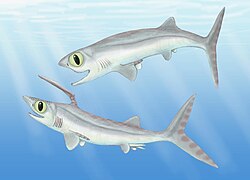Paleoecology
The bear gulch limestone is a fossil deposit from the Big Snowy Mountains of Montana. It is a smaller part of the larger St. louis limestone, which dates to the middle carboniferous. During the time, the area was a series of mudflats and lagoons with brackish and freshwater. [7] Many theories have been put forth for the preservation. One is that the creatures sank to the bottom and died of asphyxiation in the oxygen poor waters, being preserved without scavenging took place. [8] Another theory is that the bottom of the bay created mudslides because of heavy rainfall, which rapidly buried the creatures. [9] However, because many of the fish fossils were found with distended gills, this would suggest death by asphyxiation. [10] Falcatus lived alongside many strange creatures like the chondrichthyans Agassizodus, Listracanthus [11] and Delphyodontos. [12] It also lived alongside many ray-finned fish like Discoserra [13] and Paratarrasius. [14] Other fish included the rhabdodermatid Cardiosuctor, [15] the rhizodont Strepsodus, [16] and Hardistiella , one of the oldest known lamprey. [17] The invertebrates of bear gulch were very diverse creatures, like the hoplocarids (relatives of the mantis shrimp), [18] Anderella , which is the youngest known synziphosurine [19] and more enigmatic creatures like the potential gastropod relative Typhloesus, [20] and the "Square objects" which might be sea salps or cnidarians. [21] Other inverts include, mollusks like the nautiloid Tylonautilus, [22] pterioid bivalves which have been found encrusting sargassum like brown algae [23] as well as productid brachiopods, [24] Paleolimulus, [25] phyllocarids [26] and echinoderms like Crinoids, echinoids, sea stars, brittle stars and a many armed starfish called Lepidasterella montanensis. [27]
This page is based on this
Wikipedia article Text is available under the
CC BY-SA 4.0 license; additional terms may apply.
Images, videos and audio are available under their respective licenses.









